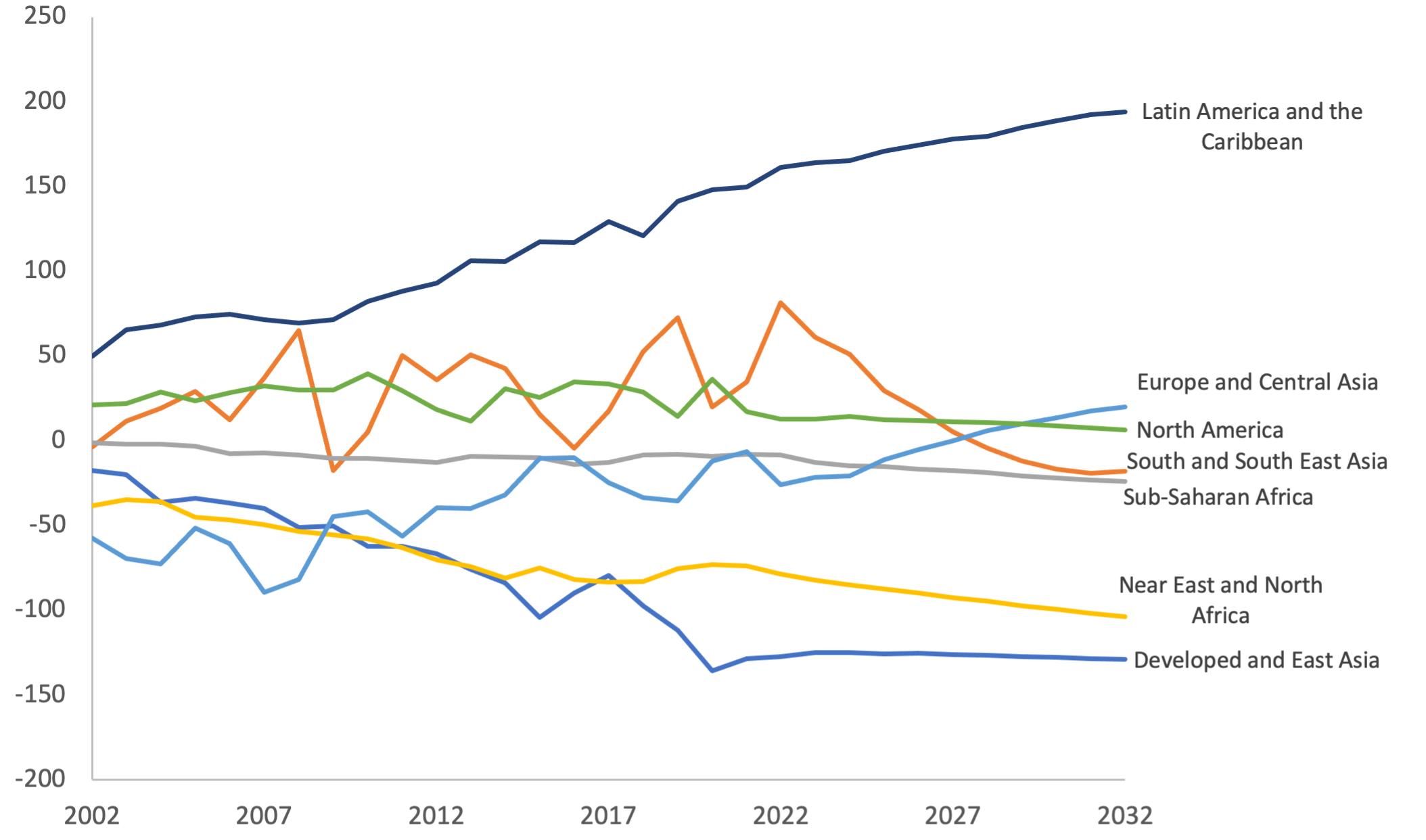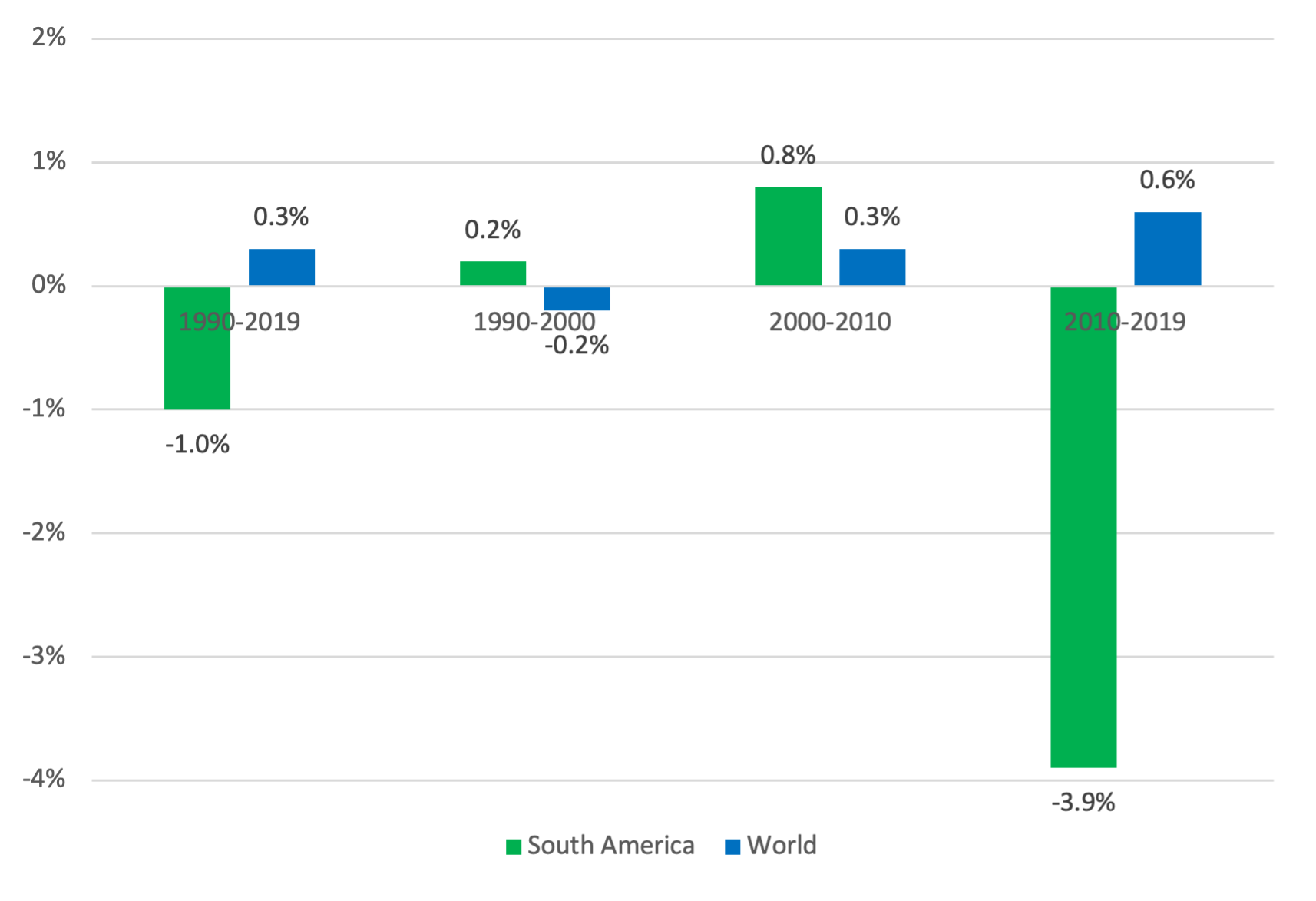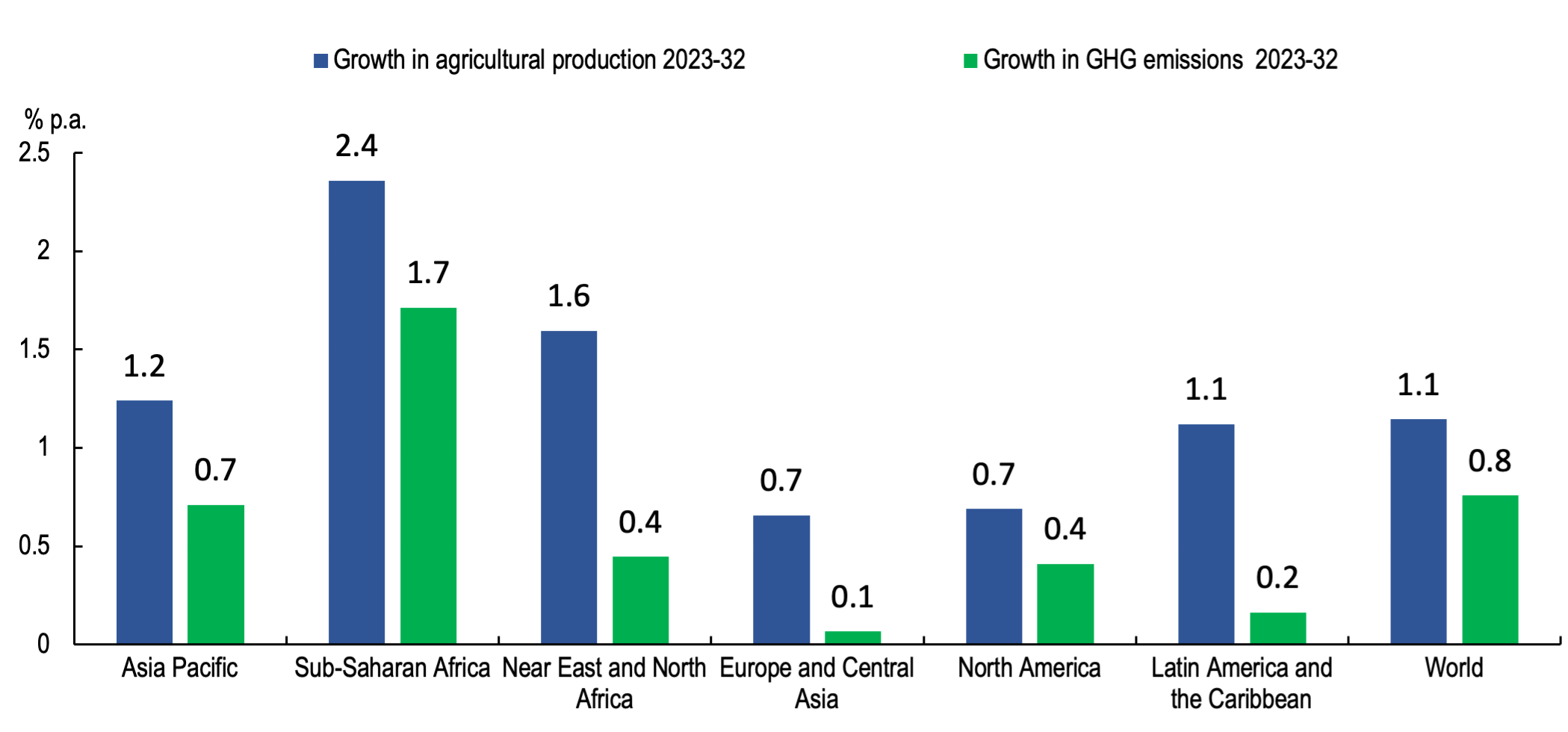Promoting food security and environmental sustainability through trade policy in the Southern Cone

- Americas : Latin America and the Caribbean
- Trade
- Food Systems
- Food Security
- Climate Change
- Value Chains
- Sustainable Development Goals (SDGs)
Related blog posts
This blog is based on finding from the IFPRI discussion paper, From farm to table: Agrifood systems and trade challenges in the Southern Cone.
Introduction
Food production, distribution, and consumption activities are extremely vulnerable to climate shocks, but these activities also contribute over 30 percent of global greenhouse gas emissions (Tubiello et al. 2021). In recent years, there has been growing recognition for the role that food systems must play in achieving the Sustainable Development Goals (SDGs) and the Paris Agreement’s climate goals. These linkages have been highlighted at key international summits, including the United Nations Food Systems Summit (UNFSS), which explored the ways food intertwines with livelihoods, nutrition and health, equity, and environmental concerns (Kalibata 2021), and COP28, which noted the challenges and opportunities inherent in food systems to mitigate and adapt to climate change.
As a critical global food exporter of wheat, soy, and other major crops, the Southern Cone has a leading role to play in global efforts to transform food systems and ensure sustainable food security and economic development.
A key challenge for Southern Cone policymakers, however, is responding to the need for more sustainable and nutritious food production without disrupting production and trade flows in ways that would increase food insecurity. As recent events such as the war in Ukraine and increased trade barriers have demonstrated, disruption in the production and trade of food can produce ripple effects around the world and threaten food security for vulnerable groups. To minimize future disruptions and find optimal production and trade strategies, net food exporters must be proactive in responding to expanding food systems goals, which now go beyond ensuring food security and productivity to emphasize elimination of policies that are not compatible with sustainability, nutritional, and health objectives. A transparent and predictable international trading system will be an essential step in these efforts, helping policymakers mitigate emerging regional imbalances and support sustainable global development.
The role of the Southern Cone
The Southern Cone, led by Brazil and Argentina, have become the largest net food exporting region in the world (Figure 1). Latin America and the Caribbean (LAC) represents 36 percent of the world's net food exports, covering more than one-third of the global food deficit. However, South American countries themselves account for more than 85 percent of this regional surplus (OECD-FAO 2022). This share is expected to increase and far outpace the next largest net food exporting region, Europe and Central Asia, through 2031.
Figure 1. Agricultural trade balances by region (billion 2014-16 US$), 2002-2032
Source: OECD-FAO 2023
Sustainable food production in the Southern Cone
Relative to many parts of the global south, production in South America, and the Southern Cone in particular, is largely sustainable. As shown in Figure 2, the agriculture and land use and land use change (LULCF) sectors have exhibited a downward trend in emissions in these countries thanks to investment in sustainable intensification technologies and practices. Southern Cone policymakers have also taken meaningful steps to ensure the protection of natural resources; for example, around 257 million hectares of forests in South America are under different environmental protection schemes. The region has also made significant progress tracking and regulating exports to guarantee agrifood products are not produced on land that underwent illegal deforestation. Southern Cone countries can leverage this strong foundation moving forward to increase production while protecting the environment and possibly converting their agrifood sector to a net carbon sink.
Figure 2. Evolution of agriculture and LUCF sector GHG emissions* (MtCO2eq.), 1990-2019
Source: Piñeiro et al. 2023 based on CAIT data 2022
Note: “Cumulative annual growth. MtCO2eq = metric tons of CO2 equivalent.
Reducing trade barriers and increasing production in the Southern Cone could lead to further significant environmental benefits. Evidence indicates that increased production in Latin America produces fewer GHG emissions compared to other regions (Figure 3). The region’s current low levels of producer support also leave a wide margin to improve the productive and environmental performance of South America’s agrifood systems through public policy. Increasing support conditional for environmentally friendly practices or utilizing other sustainability incentives could show large returns. These policies may also prove easier to implement in the Southern Cone countries compared to places where subsidies and other supports have a long history and are politically turbulent.
Figure 3. Annual change in agricultural production and direct GHG emissions, 2023-2032
Source: OECD-FAO 2023
Challenges to promoting healthy and sustainable food production while ensuring food security
Southern Cone countries face several major challenges to further developing their sustainable food systems and trade networks. Within the region, tariffs and border measures, including export restrictions and export taxes, prevent producers from accessing global and regional markets. In addition, while producer supports are generally low, some Southern Cone counties continue to fund domestic subsidies and export subsidies that distort production, investment, and trade.
Globally, policies intended to promote sustainability in food systems can present both opportunities and obstacles for Southern Cone countries and net-importing countries seeking to access major potential trade partners. Scenario analysis of the European Union’s Farm to Fork strategy, for example, suggests that production and welfare in the Southern Cone could increase as these countries receive better terms of trade from importing partners in response to reduced productivity and less competitive exports from the EU. However, if European policies are adopted more broadly or if pesticide and livestock requirements are implemented as trade barriers that require changes in LAC production practices, this could lead to lower production for most countries and products.
Public and private environmental requirements or standards that correspond with the implementation of more environmentally friendly production practices pose similar trade-offs. These standards, which have proliferated rapidly in recent years, can promote sustainable development, make sustainable products more competitive, and help differentiate these products for consumers interested in ethical consumption. However, they also are often criticized for lacking a strong scientific basis and pose a potential barrier to trade that may conflict with WTO rules that require transparency and a scientific justification for health and safety measures. Creating a formal benchmark or recognition process could help harmonize the abundance of current standards, making them more accessible, consistent, and reliable for both consumers and producers. Such harmonization would require products to be traceable across value chains to ensure requirements are met throughout the supply processes. Reenforcing these standards should also be accompanied by capacity strengthening and technology transfers for producers, especially in low- and middle-income countries (LMICs), to aid them in meeting these requirements and ensuring equity.
Finally, most Regional Trade Agreements (RTAs) do not include significant environmental provisions. This is a major policy gap that must be addressed to align food systems with global goals. Including such provisions in trade agreements can facilitate the coordination of sustainability policies across countries to prevent trade disruption and incentivize stakeholders to invest in sustainable production. Chile’s efforts to include environmental provisions in its trade agreements are noteworthy, particularly in its RTAs with Colombia, Turkey, Malaysia, and Panama, all of which include substantive environmental provisions. Such efforts have been successful at promoting sustainable practices and could serve as a model for other countries in the region. Another example is the 2020 agreement between the EU and Mercosur countries, which included an entire chapter on “Trade and Sustainable Development.” These cases can provide a strong example for future trade agreement with countries in the Southern Cone.
General conclusions and recommendations
As critical global exporters, Southern Cone countries must adapt their agrifood policies to promote both food security and environmental sustainability. Trade is one critical tool to achieve these goals. In particular, three dimensions of trade policy reform should be considered: (1) gradual trade liberalization for agrifood products; (2) elimination of unfair competition (subsidies); and (3) compliance with sanitary and phytosanitary (SPS) requirements.
To achieve these reforms, policymakers should address the following specific issues:
- Generating scientific information through research collaborations, data collection initiatives, and knowledge-sharing platforms can provide a solid basis for designing effective policies and interventions.
- Harmonizing trade policies, ensuring fair competition, and integrating environmental and social standards into trade agreements can help achieve a more equitable and sustainable trade framework.
- Transparent trade is crucial for building trust and ensuring fair practices in the food system. Promoting transparency requires harmonizing trade barriers, implementing traceability systems, and enhancing information sharing among stakeholders.
- Promoting adoption of sustainable practices necessitates capacity building, technical assistance, financial incentives, and supportive policies and regulations.
- Development of a global labeling system is essential for enhancing transparency and providing consumers with accurate information. This system should be developed through an international agreement facilitated by organizations such as the Codex Alimentarius, FAO/WHO, the High-Level Panel of Experts, and the UN Forum on Sustainability Standards (UNFPSS). It should integrate nutritional declarations with front-of-package labeling, comprehensive back-of-package labeling, and claims for consumers. Standardizing labeling criteria through QR tools and the GS1 global registration platform can streamline implementation and reduce costs.
- Comprehensive impact analysis is crucial for informed decision making and can provide valuable insights into the potential outcomes of different policy options to guide the development of more effective strategies.
- Illegal deforestation poses a significant threat to the environmental sustainability of the Southern Cone food systems. Collaboration among government agencies, civil society organizations, and the private sector is crucial for effective forest protection and restoration efforts.
Brian McNamara is a Program Coordinator with IFPRI's Markets, Trade and Institutions Division.
References
Kalibata, Agnes. (2021) The Food Systems Summit: A New Deal for People, Planet and Prosperity. United Nations, New York. https://www.un.org/en/food-systems-summit/news/food-systems-summit-new-deal-people-planet-and-prosperity
OECD/FAO. (2023), OECD-FAO Agricultural Outlook 2022-2031. Paris: OECD Publishing,
https://doi.org/10.1787/f1b0b29c-en
OECD/FAO. (2023), OECD-FAO Agricultural Outlook 2023-2032, OECD Publishing, Paris, https://doi.org/10.1787/08801ab7-en.
Piñeiro, Valeria; Piñeiro, Martín; Bianchi, Eduardo; Elverdin, Pablo; Illescas, Nelson; Papendieck, Sabine; Pascuzzi, Nieves; and Rodriguez, Augustín Tejeda. 2023. From farm to table: Agrifood systems and trade challenges in the Southern Cone. LAC Working Paper 30. Washington, DC: International Food Policy Research Institute (IFPRI). https://doi.org/10.2499/p15738coll2.137016
Tubiello, F. N., Karl, K., Flammini, A., Gütschow, J., Obli-Layrea, G., Conchedda, G., ... & Torero, M. (2021). Pre-and post-production processes along supply chains increasingly dominate GHG emissions from agri-food systems globally and in most countries. Earth System Science Data Discussions, 2021, 1-24.


